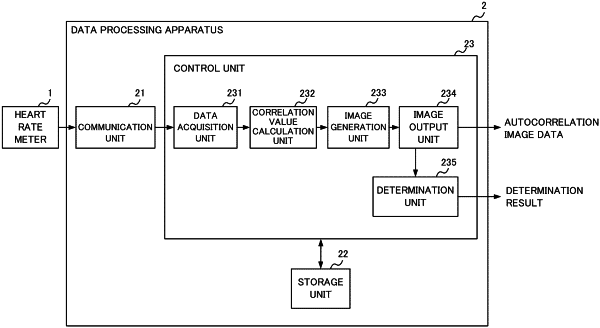| CPC A61B 5/361 (2021.01) [A61B 5/02405 (2013.01); A61B 5/1102 (2013.01); A61B 5/7246 (2013.01); A61B 5/7267 (2013.01); A61B 5/7289 (2013.01)] | 8 Claims |

|
1. A data processing apparatus comprising:
a processor; and
a memory having instructions stored thereon that, when executed by the processor, cause the data processing apparatus to:
acquire waveform data corresponding to biological information correlated with a measured heart rate;
generate, based on the acquired waveform data, a plurality of pieces of time series data whose starting timings are different from each other, wherein the starting timings of each of the time series data are delayed from one another by a lag of a plurality of lags;
calculate autocorrelation values of the plurality of pieces of time series data for the lags of the plurality of lags;
generate autocorrelation image data by mapping pixel values corresponding to the autocorrelation values in a coordinate plane having a first axis and a second axis, wherein a timing corresponding to each autocorrelation value is assigned to the first axis and the lag corresponding to each autocorrelation value is assigned to the second axis;
select a machine learning model of a plurality of machine learning models based on the measured heart rate, wherein
the machine learning models of the plurality of machine learning models are each associated with an average heart rate, and a selected machine learning model is the machine learning model associated with an average heart rate corresponding to the measured heart rate, and
the machine learning models of the plurality of machine learning models are created by using (i) autocorrelation image data based on time series data acquired in a state where atrial fibrillation is occurring for an average heat rate associated with the machine learning model being created, and (ii) the autocorrelation image data based on the time series data acquired in a state where atrial fibrillation is not occurring for the average heart rate associated with the machine learning model being created, as training data;
input the autocorrelation image data to the selected machine learning model to determine whether or not arrhythmia or atrial fibrillation has occurred based on a pattern of the autocorrelation image data; and
output the autocorrelation image data.
|